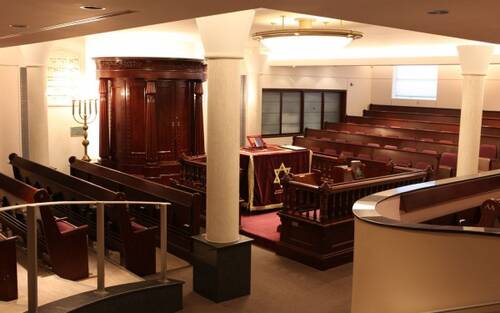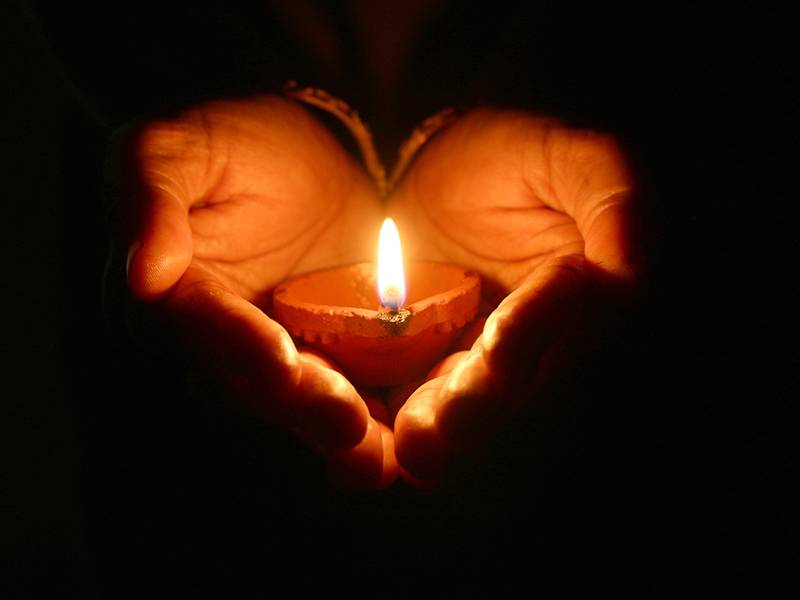Bonjour / Hello [nickname_else_first_name]
Table of contents
1) Perashat Hashavoua - Rabbi Eli Mansour
2) Halakhat Hashavoua (Halakhot related to day to day life) By Hazzan David Azerad
What May One Light With, and How Many Candles -Peniney Halacha
3) Holy Jokes!
4) For KIDS

This Week's Parasha Insight with Rabbi Eli Mansour
Parashat Lech Lecha- Abraham Abinu and Kiddush Hashem
The story of Abraham Abinu can be examined from many different angles. Numerous different themes underlie the events told about our great patriarch in the Torah and in the Midrashim. One such theme is Kiddush Hashem – glorifying the Name of God in the world.
We read in Parashat Lech-Lecha of a conflict that arose between Abraham’s shepherds and those of his nephew, Lot, who had accompanied him when he relocated in Eretz Yisrael. The Sages explain that Lot, whose ethical standards were not the same as his illustrious uncle, allowed his shepherds to bring the animals to graze in private property. Lot justified the theft of pasture on the basis of the fact that God promised the land to Abraham and his descendants. Abraham, however, realizing that the promise had not yet been fulfilled, insisted that the animals must not graze on private lands. Ultimately, Abraham suggested to Lot that they part ways, "Ki Anashim Ahim Anahnu" ("because we are brothers" – 13:8). Rashi (in his second interpretation to this verse) explains that although Lot was Abraham’s nephew, and not his brother, he nevertheless referred to him as a brother because they looked alike.
The obvious question arises, why would this outward resemblance be a reason for Abraham and Lot to separate? Why did Abraham say to Lot that they should part ways "because we look alike"?
The Hatam Sofer (Rabbi Moshe Sofer of Pressburg, 1762-1839) explained that since Lot looked like Abraham, his unethical conduct would besmirch Abraham’s name, thus causing a Hillul Hashem (defamation of God’s Name). People would mistake Lot for Abraham, and thus conclude that Abraham was stealing pasture. They would then begin to ask, "This is how a person who claims to represent God acts? Is this man somebody who I should listen to? Is this what happens to somebody who believes in God?" Abraham thus decided that there was no choice but to separate from Lot.
Later, Lot settled in the city of Sedom and was captured during a major war. Abraham mobilized a small army and, miraculously, defeated the four large empires that had conquered Sedom and taken Lot into captivity. He freed all the captives and returned all the stolen property. Remarkably, he refused to take any of the property for himself. Even though he had put his life on the line, and it was only due to his efforts that the property was returned, he refused to accept any remuneration. Abraham realized the kinds of things that would be said about him if he would take some of the spoils. "Look at this so-called man of God! He’s just out for the money!" He was so sensitive to preserving his reputation, so as not to cause God’s name to be defamed, that he calculated every decision he made and considered the consequences. Abraham lived his life for the purpose of glorifying the Name of God, and avoided anything that might potentially do the opposite.
As the descendants and inheritors of Abraham Abinu, this must be our mission at every moment in our lives – to ensure that God’s Name is glorified. We, like Abraham, must carefully weigh our words and actions. We must ensure that after every meeting and encounter with a non-Jew, or non-observant Jew, he walks away saying, "Look how honest those religious Jews are! Look how polite, courteous and pleasant they are. What a special nation!"
Unfortunately, this lesson has been lost upon many Jews in our time. Once, after speaking on this topic, I was approached by somebody in the audience who said to me, "Rabbi, Moses is Moses, but business is business." Meaning, the lofty concepts of Kiddush Hashem and honesty belong in the synagogue, in the Bet Midrash, in the yeshivot, but not in the office. When we get out into the business world, this person believed, it’s a free-for-all. We do whatever we need to do, regardless of how it affects the Jews’ reputation.
This is a terrible mistake. Our entire lives must be lived for the sake of Kiddush Hashem – at home, in the synagogue, at work, everywhere.
Rav Shimon Schwab (Germany-New York, 1908-1993) was once audited by the IRS. The auditor searched through the Rabbi’s papers, and was astonished to see how every dollar was accounted for, and all the paperwork was impeccably organized and in order. When he was finished, he said, "This man has restored my faith in humanity." As a tax auditor, this man saw people cheating and lying every single day. It was a great Rabbi who restored his faith in the nobility of people, in the ability of people to act honestly.
This is the kind of Kiddush Hashem that Abraham Abinu taught us. It behooves us all to perpetuate this legacy and follow his example, ensuring to always act in a way that brings admiration for Torah and the Jewish people, and not, Heaven forbid, the opposite.

Halachot this week are selected and Translated by Hazzan David Azerad
What May One Light With, and How Many Candles -Peniney Halacha
The second chapter of Tractate Shabbat contains an extensive discussion about the materials that may be used for lighting Shabbat candles. The general principle is that the wick needs to be soft and absorbent so that it will draw the oil nicely, and the oil must be of a type that is drawn nicely into the wick. If these conditions are not met, the flame will jump around the wick and the light will dim. There is concern that one seeing such light will try to fix it, thus transgressing the prohibition of lighting a fire on Shabbat.
The Sages said that of all of the acceptable oils, olive oil is the best because it is easily drawn into the wick and its light is clear and pure (SA 264:6). Today, most women light paraffin or “wax” candles, whose light is stronger and more stable.
The extensive discussion about the materials that can be used to light candles alludes to the way to achieve shalom bayit. Just as the wick has to be made of a soft and absorbent material and the oil must be light and easily drawn, so too a couple needs to unite humbly. Just as when we light the wick, fire and light are produced jointly by the wick and fuel, so too a couple, through the fire of faith and light of Torah, can become one, developing and illuminating together. Without a spiritual destination, love withers, just as everything physical atrophies. But when there is a shared spiritual goal that lights the fire of their lives, their love becomes stronger and stronger.
The law requires that only one candle be lit, thus providing light in the home. However, the custom is to light two candles, one corresponding to Zakhor and the other to Shamor. Some women customarily light one candle for each member of the household; others light seven candles, corresponding to the seven days of the week; still others light ten, corresponding to the Ten Commandments. All these customs apply when a woman is in her own home, but if she is a visitor in someone else’s home, the custom is that she lights just two candles (SSK 43:3).
In the past, when homes were normally candlelit, adding more candles beautified Shabbat by increasing light in the home. Now that electric light is common, adding candles does not increase beauty, and it is sufficient to light just the two candles corresponding to Zakhor and Shamor.
If a woman forgets to light candles one week, it is customary for her to add an extra candle every week as a penalty (Rama 263:1). However, this only applies if there was no light at all as a result of her omission. If there was electric light, even though she did not light it to honor Shabbat, since in fact they did not miss out on oneg Shabbat, she is not obligated to add a candle every week for the rest of her life (See Darkhei Moshe, ad loc..; BHL s.v. “she-shakheĥa”; Yalkut Yosef 263, n. 42).
Bevirkat Shabbat Shalom Umevorach
David Azerad
3) HOLY JoKeS!!
Selection of funny snippets, loosely related to this weeks parashah or current events, to brighten your day



4) FOR KIDS

Click on the image above to open the youtube video
ACTIVITY - FOOTPRINTS AND STAR GLOBE) (click on image to go to site)















